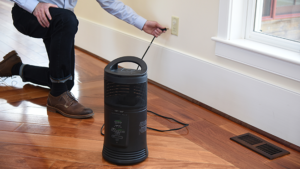
Plug an electric space heater directly into an outlet, not a power strip or extension cord.
Space heaters offer a portable and relatively affordable means of taking the chill out of small spaces. But portable heaters are also a significant source of home fires each year. When you’re in the market for a space heater, be sure to keep safety in mind.
The National Fire Protection Association’s January 2021 report on home heating fires found that space heaters were responsible for two in every five home heating equipment fires and 81% of deaths and injuries in fires caused by heating equipment.
When choosing a space heater for your home, look for features that help reduce the risk of fire or injury.
COMMON TYPES OF SPACE HEATERS
The four most popular types of electric space heaters are:
- Oil-filled radiators: Heated oil travels through the heater
- Fan-forced: A fan blows warm air over metal coils
- Ceramic: Air is warmed over a ceramic heating element
- Infrared: Heat is created by infrared bulbs
Note that unvented kerosene and gas heaters have been banned in many jurisdictions. Kerosene, gas and propane heaters — anything that uses ignitable liquids or ignitable gases as fuel — present additional risk of death or injury from carbon monoxide poisoning and are not recommended for use in closed spaces.
AVAILABLE SAFETY FEATURES
When purchasing a space heater, look for these safety features:
- Tip-over switch: Automatically shuts the unit down if it is not sitting in the upright position
- Automatic shutoff/overheat protection: Automatically shuts down the unit in case of overheating
- Thermostat: Monitors ambient room temperatures, as well as the heater temperature, and turns the unit on or off automatically
SAFETY TIPS
- Purchase a space heater only if it has been listed by a qualified testing laboratory such as Underwriters Laboratories. A UL stamp shows that the unit has undergone extensive safety testing.
- Check the Consumer Product Safety Commission’s Safer Products website to see if your heater has been recalled.
- Read the instructions and owner’s manual. If you don’t have instructions or a manual, visit the manufacturer’s website or call their customer service number to obtain a copy.
- Place the heater in areas where you can maintain adequate clearance: a minimum of 36 inches between the heater and surrounding combustibles. Take care not to set up the heater near curtains or papers.
- Select a heater with an automatic shutoff that activates if the unit tips over or overheats.
- Plug the heater directly into a wall outlet, not into a power strip or extension cord.
- Set up the heater out of the way of foot traffic, on a flat surface and clear of exit routes. Never run the heater near wet surfaces.
- Turn the heater off and unplug it before you leave the premises or before you go to bed. Don’t run the heater unattended.
- Make sure your home’s smoke detectors are in working order.
This loss control information is advisory only. The author assumes no responsibility for management or control of loss control activities. Not all exposures are identified in this article. Contact your local, independent insurance agent for coverage advice and policy service.
